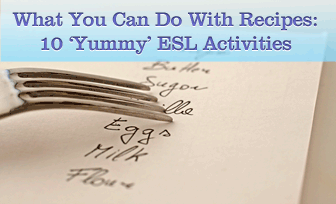What You Can Do With Recipes: 10 Yummy ESL Activities

![R: Ridiculous Recipes - Giving Instructions for Crazy Concoctions [Teacher Tips from A to Z]](https://m.busyteacher.org/uploads/posts/2011-08/1312601502_esl-cooking-class.png)
Your students should stretch their creativity and get some laughs in the process in this not so traditional cooking lesson.
Mis En Place
When starting your lesson on ridiculous recipes, get your students in the right mindset by providing some cookbooks for them to browse. You will want to select the cookbooks based on the age of your students. The examples you give can be whimsical like Mud Pies and Other Recipes: A Cookbook for Dolls or serious like Kids’ First Cookbook: Delicious Nutritious Treats to Make Yourself. You may also want to cut out selections from the weekend newspaper which often contain recipes. Allow your students to look at these books and see the format that recipes generally take.
To make sure your students understand how to read a recipe, make copies of one recipe for the entire class or project a recipe on your front board. Lead a discussion with your students in which you point out what types of information a reader can get from a recipe (ingredients, number of servings, sequence of steps and time of preparation). Then allow your students to share cooking experiences they have had in the past. You may even want to share a cooking video available on YouTube.
One of the most well known concoctions has to be the secret potion mixed up by the three witches in Shakespeare’s Macbeth. “Eye of newt and toe of frog… Wool of bat and tongue of dog…” You may have to review some of the vocabulary with your students before they understand, but once they do ask them how this differs from a traditional recipe. You can also read portions of the book Stone Soup to give your students another example of a cooked up mixture.
Preheat Oven
Before assigning the writing topic, brainstorm, as a class or in small groups, real foods that you and your students like to eat. Then tell your students that they will make up a recipe for a strange and imaginary food. They can take a twist on a food that is on your list or come up with a new idea all together. The food that they choose to write about should be something completely strange and not something you would ever really make. They might be something like pickle ice cream, hot dog salad, or shoelace pasta. The more creative and outlandish your students’ ideas, the better.
Now compile a list of cooking techniques that someone might find in a real recipe. Your students can use the cookbooks for examples such as dice, sauté, bake, whip, steam, etc. Encourage your students to use strange techniques in addition to standard cooking methods when writing their ridiculous recipes, the more outlandish the better.
Cook Until Golden Brown
Give your students time to write their recipes. Make sure they understand that the ingredients should be listed before the steps in the cooking process and that those ingredients should be listed in the order they appear in the instructions. If desired, allow your students to illustrate their recipes and then share them with the class. You can compile all the recipes into a class book and make it available with the other cookbooks for free reading time. Your students should have fun as they stretch their imaginations and creativity when writing their recipes.
After writing their ridiculous recipes, you can repeat the writing exercise by having students write out real recipes for foods that they know how to cook. You can even give them an opportunity for public speaking by letting them demonstrate their recipes in front of the class. It may also give you and your class a free lunch which is sure to lift everyone’s spirits. Take it to the next step by writing process essays. Your students can use either of their recipes, but this time write them in essay format rather than recipe format.
The practical benefits will allow your students to read and follow a traditional recipe, too. Who knows? There may be a future chef among you.